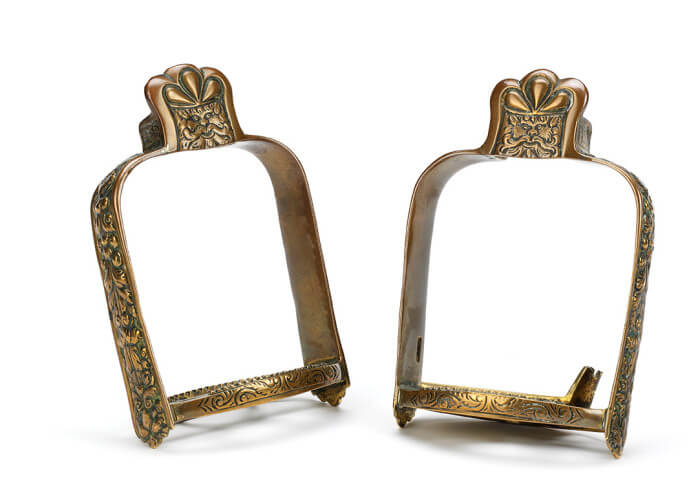Made from brass, these ornately decorated stirrups were fashioned for the Earl of Uxbridge who served as Second-in-Command during the Battle of Waterloo, and commanded the cavalry and horse artillery.
Made from brass, these ornately decorated stirrups were fashioned for the Earl of Uxbridge who served as Second-in-Command during the Battle of Waterloo, and commanded the cavalry and horse artillery.
As the battle reached its climax Uxbridge sustained a serious injury when a canon ball narrowly missed the Duke of Wellington, passing over his horse’s head before it struck Uxbridge’s right knee and shattered the joint. Uxbridge reportedly cried out “By God, sir, I’ve lost my leg!” To which Wellington calmly replied, “By God, sir, so you have!”

Uxbridge survived the amputation of his leg and remained an active individual, riding and shooting as he had done before that ill-fated day at Waterloo. It is believed that these stirrups played an important role in enabling Uxbridge to remain steady on his mount whilst using his artificial leg. In particular, the right stirrup appears to have been adjusted to include a notched metal wedge. This would have kept Uxbridge’s artificial leg locked in place.
Always known as a fashionable beau, Uxbridge seems to have kept up with fashion even down to the last piece of horse furniture. This is supported by the ornate design of this object, its decorations based on naturalistic details such as the foliage running along the sides of the stirrups and the stylized lion’s heads emerging from the swirling bracken. Atop the stirrups a bearded face with features akin to leaves stares out from the metallic surface, possibly reminiscent of the legendary Green Man.
One story which may have involved these stirrups tells how, during a banquet to celebrate the coronation of George IV in 1821, Uxbridge, Wellington and the deputy Earl Marshal were tasked with riding the extent of the interior of Westminster Hall, while wearing all the trappings worthy of the House of Lords. After approaching the new Sovereign, who was seated at the head table, the three horsemen had to reverse their horses out of the Hall. Despite his missing leg, it is claimed that Uxbridge accomplished this with “…exquisite grace…”
Uxbridge’s stirrups are a fascinating reminder of how humankind adapts, develops and creates new ways to aid those scarred by war. This small adjustment to these stirrups, shows the development leading up to the modern aids which are used for the amputees of recent conflicts.